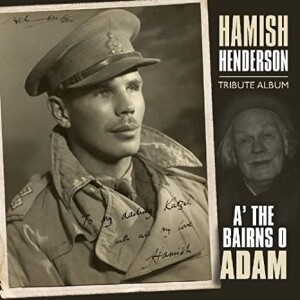 With a tribute album, if you are not familiar with the artist as a person or what he has done, then looking at the album cover in a record store is about as much use to you as a one legged man in a bum kicking contest. I fear this may be the case with this album for most people who live outside Scotland and Edinburgh in particular.
With a tribute album, if you are not familiar with the artist as a person or what he has done, then looking at the album cover in a record store is about as much use to you as a one legged man in a bum kicking contest. I fear this may be the case with this album for most people who live outside Scotland and Edinburgh in particular.
I have to confess that apart from the name, I was less than familiar with Hamish Henderson; I never heard him perform or knew what he was famous for. Fortunately, I know a man who does: Gordon Morris, the other half of Hamish’s group, Marrowbones. From about 1975 to 1984, Gordon lived in Lanarkshire and sang with a folk group called Dobies Loan. Another member of the group was wee Wattie Wright, who knew Hamish and introduced Gordon to him. So I hope I can give you an insight to the life of Hamish Henderson.
Hamish Henderson, a proud Scotsman, lived in Edinburgh. He was fluent in German and Italian, in addition to his native tongue. This proved very useful at the outbreak of the Second World War. He enlisted in the Army with the rank of captain. His job was to interrogate German and Italian POWs. In Sicily, he was rapidly promoted to colonel, and it was to Hamish that the Italians eventually capitulated. After the war, Hamish was often to be found with his dog in Sandy Bells pub and other folk clubs, singing and reciting his poetry in and around Edinburgh.
Hamish was perhaps more famous for his war poetry than music, but he wrote the song ‘Ballad of the D-Day Dodgers’ using the tune to ‘Lily Marlene’. This is the opening track on the album, beautifully sung by Rod Paterson. Dr Fred Freeman reads the poem ‘So Long’ on the second track. He also wrote the notes in the album booklet and produced the album.
Hamish is heard on two tracks, including ‘The 51st Highland Division’s Farewell to Sicily,’ put to the tune “Farewell to the Creeks.” The second, is ‘Mouth Music’ a tune with no real words, just words that are gibberish.
‘Rivonia’ by the Corrie Folk Trio has to be my favourite track out of the 16.
The album’s title comes from the words of what is regarded by many as one of Hamish’s most popular works, ‘The Freedom come-all-ye,’ which is sung by Jim Read to the tune ‘The Bloody Fields of Flanders’ (MacLellan). Other luminaries of the Scottish folk scene paying homage on the album include Alison McMorland, Adam McNaughtan, Margaret Bennett, Geordie McIntyre, Gordeanna McCulloch, The Laggan, The Euridice Choir, Jeannie Robertson, and Dick Gaughan. All do a sterling job with the songs or readings they perform.
To be fair, I think you have to be in the right mood to digest and really appreciate a tribute album such as this, or take the time to research and find out more about Hamish Henderson the man. If you do, you will find there was more to the man than is apparent from the album cover. Best remembered as being part of the 1950s folk revival, the poet, songwriter, soldier, collector and academic Hamish Henderson died in Edinburgh in March 2002.
For more information about the Hamish Henderson tribute, see the Greentrax website.
(Greentrax, 2003)
